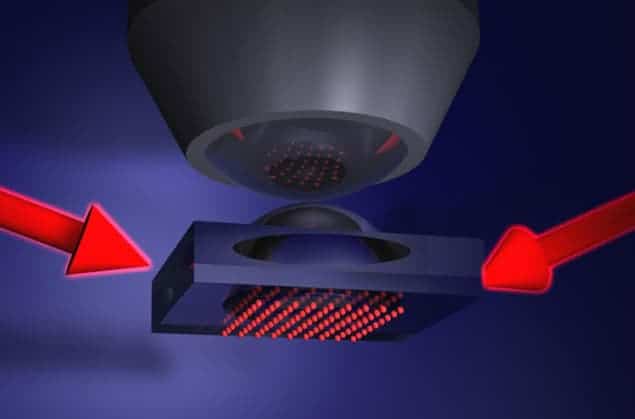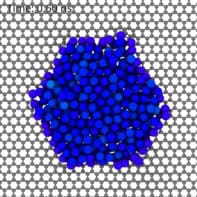
Physicists in the US have developed a new technique for cooling atoms in an optical lattice of criss-crossing laser beams. Unlike existing methods that rely on random collisions to remove hot atoms, this new scheme involves applying a precise sequence of modulations to the laser light. As well as having the potential to cool optical lattices to temperatures as low as 1 pK – well below what is possible today – the cooling algorithm could lead to quantum computers that are based on optical lattices.
Optical lattices containing just one atom per lattice site can be used to simulate a wide range of quantum phenomena that occur in solid materials, including magnetism, superconductivity and superfluidity. They are particularly useful because, unlike in solid systems, interactions between atoms in an optical lattice can be adjusted by changing the lasers or by applying a magnetic field.
Such lattices are created by first making a 2D optical lattice in a vacuum chamber using criss-crossing laser beams. The chamber also contains a very dilute gas of atoms such as rubidium. Each lattice site is an energy well, in which one or more atoms can become trapped. To ensure that each lattice site contains just one atom, physicists normally wait until random collisions involving those atoms with higher kinetic energy cause the excess atoms to be ejected from the system. However, this involves a lot of waiting around and is not specific to individual lattice sites.
Sequence of modulations
Now Markus Greiner and colleagues at Harvard University have developed a new technique that is both systematic and acts on individual lattice sites according to how many atoms they hold. The scheme relies on the fact that the excitation frequency required to eject an atom from a well depends on how many atoms are in that well. For example, when there are two atoms in a well, one atom can be ejected by modulating the depth of the well at a certain frequency. That modulation will not affect the other atom in that well – and atoms in wells containing one, three or more atoms will also be unaffected. If there are three atoms in a well, a modulation at a different frequency will eject one atom while preserving the other two. A modulation at yet another frequency will eject one atom from a well containing four atoms, and so on.
To take advantage of this feature, the team applied a carefully chosen sequence of modulations that removes the fourth, third and finally the second atom from the wells – leaving just one atom per well. The energy required for an atom to move into an (already occupied) adjacent well is extremely high, so this configuration – called a Mott insulator – will endure indefinitely. The existence of a Mott insulator is confirmed by using a special optical microscope to measure the occupancy of each lattice site.
Removing entropy
A lattice in which some wells contain two or more atoms can be thought of as a lattice with defects. Such a lattice has higher entropy than a perfect Mott insulator. This new scheme therefore reduces the entropy of the lattice – and a reduction in entropy corresponds to a drop in temperature.
Although it is difficult to quote the exact temperature to which the researchers have cooled their lattice, Greiner says that they have reached the threshold between nanokelvin and picokelvin temperatures. While this is not as low as can be achieved using other techniques, which have reached tens of picokelvin, this algorithmic cooling could point the way to achieving picokelvin temperatures in the future. Greiner also admits that the quality of the team’s Mott insulators is not as high as those made using other techniques; however he says there is room for improvement.
Quantum computers
In principle, optical lattices could also be used to store and process information in a quantum computer. Greiner points out that the lab’s microscopy technique can be used to measure and manipulate the quantum state of atoms in individual lattice sites. This means that controlled-NOT gates – a fundamental component of a quantum computer – could be implemented in an optical lattice.
The next step for Greiner and colleagues is to repeat their experiment using fermionic atoms, rather than rubidium, which is a boson. This could lead to more realistic simulations of the behaviour of electrons in solids because electrons are fermions.
Henning Moritz of the University of Hamburg in Germany describes the development of the algorithmic cooling as “a major achievement”. In particular, he believes that the technique could be crucial to gaining a better understanding of high-temperature superconductivity using quantum simulation. “The outstanding challenge is that temperatures significantly lower than those reached today have to be achieved, and this work might represent the crucial step to success,” he told physicsworld.com. Extending the technique to cool fermionic atoms would also represent an important step in this direction, he believes.
The work is described in Nature.



